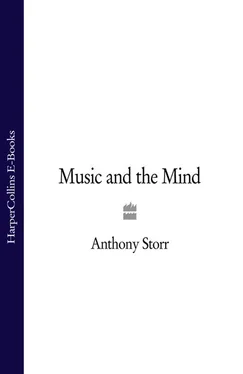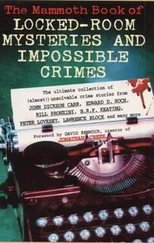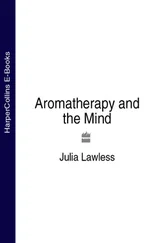CHAPTER II MUSIC, BRAIN AND BODY
Human attitudes and specifically human ways of thinking about the world are the results of dance and song.
JOHN BLACKING 1
Music brings about similar physical responses in different people at the same time. This is why it is able to draw groups together and create a sense of unity. It does not matter that a dirge or funeral march may be appreciated in a different way by a musician and by an unsophisticated listener. They will certainly be sharing some aspects of the same physical experience at the same moment, as well as sharing the emotions aroused by the funeral itself. Music has the effect of intensifying or underlining the emotion which a particular event calls forth, by simultaneously co-ordinating the emotions of a group of people.
It must be emphasized that making music is an activity which is rooted in the body. Blacking believes that ‘feeling with the body’ is as close as anyone can get to resonating with another person.
Many, if not all, of music’s essential processes can be found in the constitution of the human body and in patterns of interaction of bodies in society … When I lived with the Venda, I began to understand how music can become an intricate part of the development of mind, body, and harmonious social relationships. 2
It is generally agreed that music causes increased arousal in those who are interested in it and who therefore listen to it with some degree of concentration. By arousal, I mean a condition of heightened alertness, awareness, interest, and excitement: a generally enhanced state of being. This is at its minimum in sleep and at its maximum when human beings are experiencing powerful emotions like intense grief, rage, or sexual excitement. Extreme states of arousal are usually felt as painful or unpleasant; but milder degrees of arousal are eagerly sought as life-enhancing. We all crave some degree of excitement in our lives; and if stimuli from the environment are lacking, we seek them out if we are free to do so. Not all music is designed to cause arousal. Satie wrote music designed only to provide a comforting background. This has been succeeded by the kind of ‘wallpaper’ music played in elevators, which soothes some people and provokes fury in others. However, this is an exception and not the kind of listening being discussed at this point. Lullabies may send children to sleep; but we listen to Chopin’s Berceuse or the Wiegenlieder of Brahms and Schubert with rapt attention.
Arousal manifests itself in various physiological changes, many of which can be measured. The electro-encephalogram shows changes in the amplitude and frequency of the brain waves which it records. During arousal, the electrical resistance of the skin is diminished; the pupil of the eye dilates; the respiratory rate may become either faster or slower, or else become irregular. Blood-pressure tends to rise, as does the heart rate. There is an increase in muscular tone, which may be accompanied by physical restlessness. In general, the changes are those which one would expect in an animal preparing for action; whether it be flight, fight, or mating. They are the same changes recorded by the polygraph or ‘lie detector’ which demonstrates arousal in the form of anxiety, but which, contrary to popular belief, cannot prove guilt or innocence.
Recordings of muscle ‘action potentials’ on another instrument, the electro-myograph, show marked increases in electrical activity in the leg muscles whilst listening to music, even when the subject has been told not to move. In the concert hall, the physical restlessness induced by arousal is often insufficiently controlled. Some people feel impelled to beat time with their feet or drum with their fingers, thereby disturbing other listeners. There are tracings recording the increase in Herbert von Karajan’s pulse-rate while conducting Beethoven’s Overture, Leonora No. 3. Interestingly, his pulse-rate showed the greatest increase during those passages which most moved him emotionally, and not during those in which he was making the greatest physical effort. It is also worth noting that recordings of his pulse-rate whilst piloting and landing a jet aircraft showed much smaller fluctuations than when he was conducting. 3Music is said to soothe the savage breast, but it may also powerfully excite it.
What seems certain is that there is a closer relation between hearing and emotional arousal than there is between seeing and emotional arousal. Why else would the makers of moving pictures insist on using music? We are so used to hearing music throughout a film that a short period of silence has a shock effect; and movie-makers sometimes use silence as a precursor to some particularly horrific incident. But a love scene in a film is almost inconceivable without music. Even in the days of silent films a pianist had to be hired to intensify and bring out the emotional significance of the different episodes. A friend of mine, visiting the Grand Canyon for the first time, found himself disappointed at his lack of response to this awesome sight. After a while, he realized that he had seen the Grand Canyon many times on the cinema screen and never without music. Because his sight of the real thing lacked such musical accompaniment, his arousal level was less intense than it had been in the cinema.
Seeing a wounded animal or suffering person who is silent may produce little emotional response in the observer. But once they start to scream, the onlooker is usually powerfully moved. At an emotional level, there is something ‘deeper’ about hearing than seeing; and something about hearing other people which fosters human relationships even more than seeing them. Hence, people who become profoundly deaf often seem to be even more cut off from others than those who are blind. Certainly, they are more likely to become suspicious of their nearest and dearest. Deafness, more than blindness, is apt to provoke paranoid delusions of being disparaged, deceived, and cheated.
Why is hearing so deeply associated with emotion and with our relationship with our fellow human beings? Is there any connection with the fact that, at the beginning of life, we can hear before we can see? Our first experience of hearing takes place in the womb, long before we leap into the dangerous world and begin to look at it. David Burrows, who teaches music at New York University, writes:
An unborn child may startle in the womb at the sound of a door slamming shut. The rich warm cacophony of the womb has been recorded: the mother’s heartbeat and breathing are among the earliest indications babies have of the existence of a world beyond their own skin. 4
A dark world is frightening. Nightmares and infantile fears coalesce with rational anxieties when we come home at night through unlit streets. But a silent world is even more terrifying. Is no one there, nothing going on at all? We seldom experience total silence, except in the artificial conditions of those special rooms in psychological laboratories in which darkness is combined with sound-proofing to exclude input to our senses as completely as possible. As Burrows points out, we are dependent on background sound of which we are hardly conscious for our sense of life continuing. A silent world is a dead world. If ‘earliest’ and ‘deepest’ are in fact related, as psychoanalysts have tended to assume, the priority of hearing in the emotional hierarchy is not entirely surprising; but I think it unlikely that this is the whole explanation.
The details of the physiological responses outlined above need not detain us. We have all experienced them, and we are all aware that the condition of arousal can be exciting or distressing according to its intensity. The important point to recognize in this context is that, with a few exceptions, the physical state of arousal accompanying different emotional states is remarkably similar. Sexual arousal and aggressive arousal have in common fourteen physiological changes. The Kinsey team found that there were only four respects in which the physiology of anger differed from the physiology of sex. Although there are rather more physiological differences between the state of fear and the states of anger and sexual arousal, fear still shares nine of the same items of physiological change with the other two, including increase in pulse-rate, increase in blood-pressure, and increase in muscular tension. 5
Читать дальше












